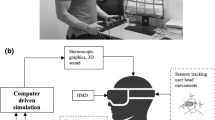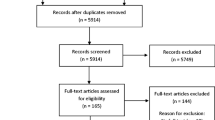Abstract
The main goal of this systematic review is to synthesize existing evidence on the use of immersive virtual reality (IVR) to train professionals as well as to identify the main gaps and challenges that still remain and need to be addressed by future research. Following a comprehensive search, 66 documents were identified, assessed for relevance, and analysed. The main areas of application of IVR-based training were identified. Moreover, we identified the stimuli provided, the hardware used and information regarding training evaluation. The results showed that the areas in which a greater number of works were published were those related to healthcare and elementary occupations. In hardware, the most commonly used equipment was head mounted displays (HMDs), headphones included in the HMDs and handheld controllers. Moreover, the results indicated that IVR training systems are often evaluated manually, the most common metric being questionnaires applied before and after the experiment, and that IVR training systems have a positive effect in training professionals. We conclude that the literature is insufficient for determining the effect of IVR in the training of professionals. Although some works indicated promising results, there are still relevant themes that must be explored and limitations to overcome before virtual training replaces real-world training.










Similar content being viewed by others
References
“CyberGlove Systems,” 2019. [Online]. Available: http://www.cyberglovesystems.com/. [Accessed: 18-Apr-2019].
“ISCO-08,” 2019. [Online]. Available: https://www.ilo.org/wcmsp5/groups/public/@dgreports/@dcomm/@publ/documents/publication/wcms_172572.pdf. [Accessed: 18-Apr-2019].
Bertrand J, Bhargava A, Madathil KC, Gramopadhye A, Babu SV (2017) The effects of presentation method and simulation fidelity on psychomotor education in a bimanual metrology training simulation. 2017 IEEE Symposium on 3D User Interfaces:59–68
Burdea GC, Coiffet P (2003) Virtual reality technology. John Wiley & Sons
Connolly TM, Boyle EA, MacArthur E, Hainey T, Boyle JM (2012) A systematic literature review of empirical evidence on computer games and serious games. Comput Educ 59(2):661–686
De Visser H, Watson MO, Salvado O, Passenger JD (2011) Progress in virtual reality simulators for surgical training and certification. Med J Aust 194(4):S38–S40
Dwivedi P, Cline D, Joe C, Etemadpour R (2018) Manual assembly training in virtual environments. IEEE 18th International Conference on Advanced Learning Technologies:395–399
Elbert R, Knigge J-K, Sarnow T (2018) Transferability of order picking performance and training effects achieved in a virtual reality using head mounted devices. IFAC-PapersOnLine 51(11):686–691
Feelreal, “Multisensory VR Mask,” 2019. [Online]. Available: http://www.feelreal.com. [Accessed: 20-May-2019].
Feng Z, González VA, Amor R, Lovreglio R, Cabrera-Guerrero G (2018) Immersive virtual reality serious games for evacuation training and research: A systematic literature review. Comput Educ 127:252–266
Haque S, Srinivasan S (2006) A meta-analysis of the training effectiveness of virtual reality surgical simulators. IEEE Trans Inf Technol Biomed 10(1):51–58
Hayward V, Astley OR, Cruz-Hernandez M, Grant D, Robles-De-La-Torre G (2004) Haptic interfaces and devices. Sens Rev 24(1):16–29
Jensen L, Konradsen F (2018) A review of the use of virtual reality head-mounted displays in education and training. Educ Inf Technol 23(4):1515–1529
Kinateder M et al (2014) Virtual reality for fire evacuation research. Federated Conference on Computer Science and Information Systems:313–321
Lombard M, Ditton T (1997) At the heart of it all: The concept of presence. J Comput Commun 3(2):1–73
Menin A, Torchelsen R, Nedel L (2018) An analysis of VR technology used in immersive simulations with a serious game perspective. IEEE Comput Graph Appl 38(2):57–73
Moher D, Liberati A, Tetzlaff J, Altman DG (2009) Preferred reporting items for systematic reviews and meta-analyses: the PRISMA statement. Ann Intern Med 151(4):264–269
Nadia Z, Pasaribu YM, Djati ID (2018) Expectations and ideal VRUI from user’s perspective, case studies: VR interface in ITB electric car’s (Molina) virtual exhibition. JCP 13(6):721–732
Pagano K, Haddad A, Crosby T (2017) Virtual reality-making good on the promise of immersive learning: The effectiveness of in-person training, with the logistical and cost-effective benefits of computer-based systems. IEEE Consum Electron Mag 6(1):45–47
Parashar NK, Kumar N (2017) A concept of digital scent/smell technology: an underrated technology. Int J Recent Innov Trends Comput Commun 5(11):254–256
Queiroz ACM et al (2018) Immersive virtual environments in corporate education and training. 24th Americas Conference on Information Systems:1–10
Ragan ED, Bowman DA, Kopper R, Stinson C, Scerbo S, McMahan RP (2015) Effects of field of view and visual complexity on virtual reality training effectiveness for a visual scanning task. IEEE Trans Vis Comput Graph 21(7):794–807
Sankaranarayanan G et al (2018) Immersive virtual reality-based training improves response in a simulated operating room fire scenario. Surg Endosc 32(8):3439–3449
Schlueter J, Baiotto H, Hoover M, Kalivarapu V, Evans G, Winer E (2017) Best practices for cross-platform virtual reality development. Mechanical Engineering Conference Presentations Papers, and Proceedings 10197:1–13
Schoor W et al (2010) VR based visualization and exploration of plant biological data. JVRB-Journal Virtual Real Broadcast 6:1–22
Slater M (1999) Measuring presence: A response to the Witmer and Singer presence questionnaire. Presence 8(5):560–565
Slater M, Wilbur S (1997) A framework for immersive virtual environments (FIVE): Speculations on the role of presence in virtual environments. Presence Teleoperators Virtual Environ 6(6):603–616
Vi CT, Ablart D, Arthur D, Obrist M (2017) Gustatory interface: the challenges of ‘how’to stimulate the sense of taste. Proceedings of the 2nd ACM SIGCHI International Workshop on Multisensory Approaches to Human-Food Interaction:29–33
Witmer BG, Singer MJ (1998) Measuring presence in virtual environments: A presence questionnaire. Presence 7(3):225–240
Zhang H (2017) Head-mounted display-based intuitive virtual reality training system for the mining industry. Int J Min Sci Technol 27(4):717–722
Acknowledgements
This work was partially financed by the ERDF–European Regional Development Fund through the Operational Program for Competitiveness and Internationalization–COMPETE 2020 Program and by National Funds through the Portuguese funding agency, FCT–Fundação para a Ciência e a Tecnologia, project POCI-01-0145-FEDER-028618 entitled PERFECT–Perceptual Equivalence in virtual Reality For authEntiC Training. This work was also partially financed by the National funding by FCT, Foundation for Science and Technology, through the PhD Research Scholarship SFRH/BD/147334/2019.
Author information
Authors and Affiliations
Corresponding author
Additional information
Publisher’s note
Springer Nature remains neutral with regard to jurisdictional claims in published maps and institutional affiliations.
Supplementary Information
ESM 1
(XLSX 31.1 kb)
Rights and permissions
About this article
Cite this article
Narciso, D., Melo, M., Rodrigues, S. et al. A systematic review on the use of immersive virtual reality to train professionals. Multimed Tools Appl 80, 13195–13214 (2021). https://doi.org/10.1007/s11042-020-10454-y
Received:
Revised:
Accepted:
Published:
Issue Date:
DOI: https://doi.org/10.1007/s11042-020-10454-y




